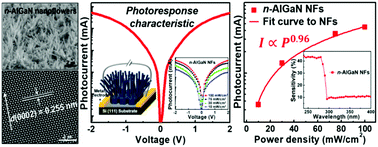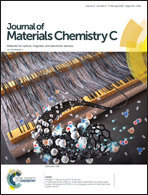Synthesis of n-AlGaN nanoflowers by MOCVD for high-performance ultraviolet-C photodetectors†
Abstract
AlxGa1−xN nanostructure based ultraviolet-C photodetectors have attracted nascent research attention owing to their low cost, tunable band gap, simple operation, and smaller and lightweight systems. However, the synthesis of high quality AlxGa1−xN nanostructures by MOCVD has been limited by their complex multi-component phase diagram and inhomogeneous composition. Here, we report the synthesis of Si-doped n-type compositionally uniform Al0.45Ga0.55N alloy with flower-like morphology (nanoflowers) by MOCVD. Quasi vertically aligned and preferentially c-axis oriented n-AlGaN nanoflowers consist of a large number of self-assembled one-dimensional nanowires that tend to grow radially from the center. The n-AlGaN nanowires are single crystalline in nature and grow along the (0002) direction. The low temperature (88 K) cathodoluminescence spectra of the AlGaN nanoflowers displayed a strong band edge emission at ∼280 nm, which shifted to ∼292 nm at room temperature. The photoresponsivity and sensitivity of the ultraviolet-C photodetectors fabricated with n-AlGaN nanoflowers are ∼0.72 A W−1 and ∼40%, respectively, at 2 V. The nanoflower based device exhibited remarkably superior photoresponse characteristics to the device fabricated with AlGaN nanorods or nanowires, which were synthesized under different MOCVD growth conditions. A large surface-to-volume ratio and a higher density of the nanoflowers enhance photon absorption, resulting in photocurrent gain, a substantially high quantum efficiency and hence improved photoresponse characteristics.



 Please wait while we load your content...
Please wait while we load your content...